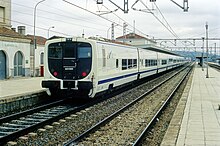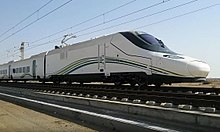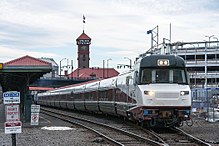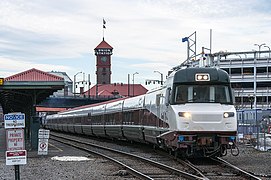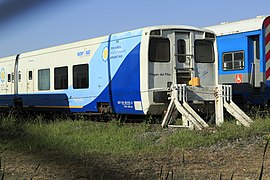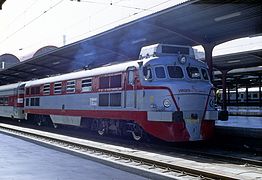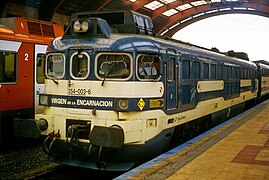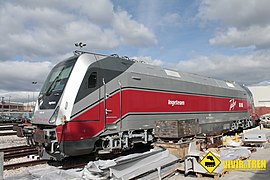Talgo (train)
It is known as Talgo (®) a type of railway towed material for the transport of passengers designed to reach high speeds safely and with exceptional conditions of accessibility and comfort. The first commercial version was built between 1947 and 1949 at the initiative of the Spanish company Patentes Talgo.
The Talgo is usually associated with the military engineer Alejandro Goicoechea Omar (1895-1984) since it was he who conceived the two prototypes that preceded the first version to enter service -the Talgo II- and, above all, he convinced the architect and businessman José Luis de Oriol y Urigüen (1877-1972) to invest in a project to modernize passenger trains at a time when the automobile and the plane were leaving the railway without passengers and in a country with a rail network in precarious conditions due to the civil war. It was also Goicoechea who baptized the train with the acronym "Tren Articulado Ligero Goicoechea Omar", a name that was not necessary to change after the creation of Patentes Talgo in 1942, since the acronym could also be read "Tren Articulado Ligero Goicoechea Oriol" 34;.
Two years after the creation of Patentes, Talgo Goicoechea definitively abandoned the project, so it had no intervention in the construction of the first Talgo to enter service, built from 1947 to 1949 in the US under a Spanish patent. The technical manager of the successive Talgo models that have rolled in the three decisive decades of Talgo (1960-1990) was the industrial engineer Ángel Torán Tomás (1925-1999), author of the patents related to reversibility (the first models were one-way, they could not reverse, which made maneuvering at stations immensely complicated) and segregation of cars (1964), the automatic track gauge change system (1968) or the pendulum Talgo (1980).
Features
Talgo compositions are mainly characterized by having a completely different rolling system than conventional train cars. This allows them a series of advantages, but in exchange, they can only build fixed convoys whose boxes can only be coupled and uncoupled in a complex workshop procedure.[1]
Since the beginning of railways, cars were made with two axles, one at each end. This forced the axles to be very close to each other, since if they were further apart, it was difficult to keep the wheels on track in the curves, so the cars had to be short. To solve this, the axles were joined in pairs in rotating carts called bogies, which allowed the cars to have much greater length by placing a bogie at each end instead of an axle.
Talgo's original solution consisted of manufacturing the shortest cars and placing the independent stands (without axles) between each one of them, joining the consecutive stands by means of a set of bars forming triangles. When entering a turn, the turning motion is transmitted through the bars causing the wheels to be positioned mechanically parallel to the rail at each point. The need to align the wheels makes it necessary to use a guidance system for the first stand. Thus, the locomotives had special stops: rigid in the 350 and 352 series and pre-compressed in the 353. On the other hand, the Talgo 4 compositions are independent of the locomotive that drags them, since the guide of the stands is achieved with some bars of assisted guidance in the second stand that guides the first when taking the curve. Thus, the flange of the first wheel only attacks the rail during the time it takes for the second wheel to enter the curve, 13 meters behind.
This perpendicular situation of the wheels increases stability and avoids the possibility that their tab attacks the rail directly, reducing friction and aggression to the track. The fact that bogies are not required makes it possible to make boxes of a lower height, so the center of gravity is closer to the track, further increasing stability. In addition, the smaller section makes the train lighter, which makes it possible to reach higher speeds with the same power as the locomotive. This characteristic was increased through the use in its construction of light alloys. Lastly, the special arrangement of the independent stands makes it easier to apply technologies such as sliding rolling or pendulum suspension.
History
Patents Talgo was created in 1942 and in the following years the Talgo 0 and Talgo I prototypes were built, whose behavior on the roads encouraged the company to consider building a commercial model. In the midst of the European post-war period, the best possibility of success was to associate with an American company and Patentes Talgo managed to close an agreement with the American Car and Foundry Company [2] in 1945. After various disagreements between Goicoechea and Oriol in 1944, Goicoechea was dismissed as director of Patentes Talgo, his position being taken by ICAI engineer Jaime McVeigh, whom the documentation for American Car & amp; Foundry attributes the draft of the Talgo II. Once the project was launched, McVeigh coordinated the different fronts and traveled continuously to Spain. Two young Spanish engineers who were specializing in the US joined the team of American engineers: the ICAI engineer Francisco Fernández de Heredia (1922-2011) was in charge of implementing the electrical system of the locomotive that was going to be adapted as traction for the cars Talgo and the industrial engineer Ángel Torán Tomás took care of the construction and verification of the structures, that is, the design of the box and the rolling system of the new train. [3]
Some 0
It consisted of only the rolling chain, formed by triangles and rods, to test the operation of the system. It seems that the idea arose from seeing an employee of a children's playground store the tricycles by mounting the front wheel of each one on the axis of the previous one.
Talgo I
It was designed before the capital contribution of the financier José Luis Oriol. It consisted of a car manufactured in 1942 by the Hijos de Juan Garay workshops in Oñate (Guipúzcoa) and those of the MZA Company in Atocha. Its main purpose was to demonstrate the operation of the new rolling system invented by Goicoechea. It had 200 horsepower provided by a Ganz diesel engine (series 202 Norte, 9,210 Renfe), and reached 115 km/h in tests. It had a curious design, with the end imitating the head of a shark.
After 3000 km of tests, this composition of seven cars was destroyed on February 5, 1944 in a fire while it was stored in a closed place, with restricted access, in Cerro Negro. The circumstances of said fire were never clarified, but it is believed that misgivings about such an innovative train caused some manufacturer, fearful of its success, to try to destroy its development in this way.
Talgo II
It was the first series commissioned for the purpose of operating regular passenger services and was manufactured in the United States by the American Car and Foundry (ACF) due to the state of the Spanish industry after the Civil War. In December 1945 an agreement was signed for the construction of two compositions and three locomotives and, in addition, ACF built a third composition with 6 trailers called Talgo model 1949. From that year until 1954, it circulated promotionally on the Lackawanna Railroad between New York and Chicago and on the Pennsylvania Railroad. The second prototype, built in 1959, was sold to Spain.
Commercial service began on March 2, 1950 on the Madrid-Estación del Norte-Valladolid-Campo Grande line. With an art deco style exterior appearance and a top speed of 120 km/h, it was based on American express cars of the 1930s-1950s, with a rounded observation car at the tail end of the train. and a luminous sign, with the name «Talgo».
In total, ACF under license Talgo, manufactured seven trains in the United States: two Talgo II for Renfe (1949), the Talgo model 1949 also for Renfe, the Talgo model 1955, the Jet Rocket for Rock Island (1956) and two John Quincy Adams, one for New Haven (1957) and one for Maine (1958).
They were withdrawn from service on January 15, 1972, with more than 8 million kilometers per composition. Part of the two compositions together with their original locomotives are preserved in the Madrid and Villanueva y Geltrú (Barcelona) railway museums.
Talgo III
They circulated between 1964 and 2010 with an innovative design in red and exposed aluminum. It began operating the highest quality lines, with a price per ticket much higher than the rest of the trains since what was called a "speed supplement" was paid. Later it has circulated on a large number of long-distance lines, both national and international —Talgo III RD—.
The series was made up of compositions and «tame», generator vans whose function was to serve as a link between locomotives of any type and the composition, without the need for the locomotives to have special stops. In addition, the Talgo III were bidirectional and not unidirectional, like the Talgo II with a negative angle of attack to the track, thanks to the neutral angle of attack of their stands.
Some Talgo III coaches with some modifications were fitted with a system that allowed —passing through a specially enabled gauge changer— to change the gauge from Iberian to international gauge and vice versa in a very short time. Cars equipped with this system they received the name of Talgo III RD. In 1968, this technology allowed the circulation of the first direct train between Madrid and Paris in tests, starting in 1969 its regular commercial service between Barcelona and Geneva, a service known as Catalán Talgo. It was the only Spanish train that belonged to the select European group of Trans Europ Express trains. In 1974 another service was inaugurated that combined the RD system with new sleeping cars —Talgo III RD Beds— called Barcelona Talgo that linked Barcelona and Paris every night in both directions.
The Talgo III RD compositions had some differences with respect to the Talgo III. They did not need the "tame" for guiding the first stand; any locomotive could do it directly if the pressure of its buffers was properly regulated. Both Renfe and SNCF did so with the locomotives destined to provide service towing them. In addition, since the RD compositions are longer, usually 12 to 16 cars in the day RD and from 16 to 20 cars in the night RD, it was necessary to place two generator cars at both ends. The Talgo III compositions only had them at one end, since they usually had 6 to 9 cars, although occasionally they were longer.
The last conventional composition that circulated had its last service on July 26, 2009, while the RD version had its last service on December 18, 2010.
Talgo 4 or Pendular Talgo
The 4 series and, on occasions, its successors, were called Talgo Pendular, due to the fact that they incorporated pendulum technology, since the cars "hung" from the suspension, while other trains, such as Pendolinos, used to be called tilting trains as they "tilted" on bogies.
As with the RD system, tilting was first tested in a prototype composition that traveled thousands of kilometers alone and coupled to Talgo III compositions during the second half of the 1970s. This composition formed by 4 Talgo III cars allowed establish not only the suitability of the system, but also the balance between comfort and performance in its operation.
The tilting technology of the Talgos consisted of the fact that the secondary suspension rose above the center of mass of the train with the pressure balls of the pneumatic suspension on the roof; thus, the cars were suspended from the shock absorbers like a pendulum. When the train took a curve, the underside would drift to the outside of the curve. The boxes leaned in the curves by centrifugal force, without the possibility of error and without energy consumption. But, as all suspension tends to put the box back in a horizontal position, there was an electro-pneumatic system that prevented the passage of air to the suspension so that the car remained tilted. This made it possible to better compensate lateral accelerations, with which corners could be taken at a higher speed while maintaining passenger comfort.
The main advantage of this system is that it hardly required maintenance or any type of motor or system that consumes energy. It is only activated if the curve has a radius of less than 1500 meters and the speed is greater than 60 km/h. From that speed, the communication between the two secondary suspension springs opens, which is what allows the train to incline a maximum of 4.5º; the system is Type B. The other tipping systems require mechanisms, generally hydraulic, which are the ones that physically tilt the upper part of the gear towards the inside of the curve. This system, more expensive to build and maintain, on the other hand, allows a greater inclination and faster cornering.
As it had been done with the Talgo III RD, the tame ones were eliminated. Furthermore, there was no need to modify the stops of the locomotives because the Talgo Pendular compositions could be pulled with any conventional locomotive. This fact greatly simplified their exploitation, since until then they had needed to be towed by specific locomotives. For the short daytime compositions, an extreme generator van was installed, for the night ones, generally longer, two extreme generator cars were used and diesel extreme vans were incorporated to supply the electricity needs of the car services.
In addition to tilting, Talgo Pendular compositions incorporated aluminum welding of the body using techniques from aeronautics. In the Talgo II, III and III RD the external aluminum plates were riveted, giving them a characteristic appearance.
The first compositions began service on July 15, 1980, with a more modern and less disruptive aesthetic than the III series. The entire series was made up of fixed tread compositions in Iberian gauge, with a maximum speed of 180 km/h. They have carried out both daytime and nighttime services under the name Talgo, Altaria, Trenhotel and Intercity, forming mixed compositions with V and VI series trailers.
In May 2021, Renfe withdrew all the daytime and nighttime compositions after 41 years of service. Many of the compositions are today isolated and in poor condition at the base of Talgo de las Matas and the workshops of La Sagra, with many scrapped trailers being found.
In 2011 Argentina would buy 4 formations for the service to Mar del Plata; They were withdrawn in 2012. But in 2022 it will return to service this time with destination Rosario The formation consisted of 9 cafeteria, Tourist and Preferred cars.
Talgo 5
It was a version of the 4 series equipped with movable wheels for international services. The RD system was more expensive and complex to maintain than conventional fixed tread; the nocturnal Talgo Pendulares received the commercial name of Trenhotel by Renfe, both those that made internal routes in Spain and international ones. They have also carried out daytime services under the name Talgo or Altaria.
Talgo 6 or Talgo 200
The series was made as an improvement of the 5 series. Its origin is closely linked to the inauguration, in 1992, of the first high-speed line in Spain, the Madrid-Seville line. When building the line in international gauge, it became necessary for variable gauge trains to be able to enter the line, to take advantage of its greater benefits, and leave it changing gauge to reach other destinations outside of it. They began to be used on May 28, 1989 on the Barcelona-Berna line and on May 31, 1993 on the Madrid-Málaga line (using the AVE line to Córdoba) with several daily connections. Other nocturnal Talgo Pendulares or Talgos III RD Camas trains also used this line covering Barcelona-Seville or Barcelona-Málaga connections. After the Madrid-Málaga AVE line was inaugurated, they currently provide other services such as Talgo, Altaria and Trenhotel. These compositions have been used for international routes between Spain and France under the name of Elipsos Trenhotel until its suppression in December 2013 due to the entry of the Barcelona Figueres high-speed line. These compositions are isolated and in poor condition. Likewise, many other compositions have ceased to provide service with the implementation of the Alvia 130/730 and 120 series on most routes.
The series makes up most of the towable Talgo compositions in service, both day and night. Other compositions from series 6 were exported to other countries, such as Germany, the United States or Kazakhstan.
Talgo XXI (Talgo BT)
Talgo XXI, also known as Talgo BT in formation with a single tractor unit, is a high-speed diesel railcar with variable gauge bogies to run on UIC or standard gauge tracks (1,435 mm) and on those of Iberian width (1,668 mm). Although the numbering of the series corresponds to a diesel locomotive (3xx), it is actually a complete train unit with a pull-push structure: tractor head, intermediate trailers and trailer-cab.
The Talgo XXI prototype is a complete Talgo train, unlike Renfe Series 102 trains or Renfe Series 130 trains whose powerheads are partially designed and built by Bombardier. It maintains all the hallmarks of Talgo: lightness, natural pendulation, wheel guidance and a low center of gravity, with the novelty of incorporating movable rolling bogies, which allows it to change track gauge after passing through any of the changers. Talgo technology, without having to change locomotives and without stopping.
In January 1999, the Talgo XXI was presented during the exhibition on the railway's sesquicentennial, held at the Estación de Francia in Barcelona. It consisted of a tractor unit made in Germany (the BT 1), four Talgo VII series cars (one Preferred class, two Tourist and Cafeteria) and a van, and it circulated for the first time on February 24. A short time later, Krauss Maffei delivered the movable rolling bogie, since the first one installed was for a fixed width. He was also seen driving with five cars and a van. In December 1999, the second tractor head was incorporated (this one manufactured in Spain: the BT 2). The two tractor units, together with a variable number of Talgo VII cars (up to seven: three Preferred cars, another three Tourist cars and a Cafeteria car) formed the Talgo XXI, which was homologated to Type 220 C.
After the testing period, and during the official presentation of the Talgo XXI (on April 3, 2000), the GIF awarded (for 7.83 million €uros, with maintenance included for 5 years) the supply of two compositions (BT 1 and 2), the result of the segregation of the prototype, and made up of a tractor unit, two VII series Talgo cars (laboratory with toilet and two-axle laboratory) and a trailer with cab, which were delivered to end of 2002. The BT compositions are homologated to Type 200 B, although limited to 160 km/h if they circulate pushing (push, with tail traction).
The Talgo XXI, in a configuration of two tractor heads and three of the definitive trailers, holds the world speed record with diesel traction, having managed to reach 256.38 km/h on June 12, 2002 in the kilometer 402.2 of the Madrid-Barcelona-France line, between Ballobar and Montagut.
Currently both trains are owned by Adif and are used as Operation Support Train. They are also corporate trains, especially BT 1, for official trips and visits to lines under construction. BT 2 is used more for catenary auscultation and track geometry auscultation, mainly on new high-speed lines; It currently has an auscultator pantograph and tracking cameras mounted.
Talgo 7
Developed from the Talgo XXI prototype, initially it consisted of simple compositions with movable rolling, with an improved design and adapted to travel at 250 km/h hauled by locomotives, without generator vans.
Given the higher speed at which they were going to circulate, the Talgo 250 cars were pressurized to avoid pressure waves in the tunnels and the braking power was increased. The air conditioning generators were also placed at the bottom of the cars and not on the side, which lowers the center of mass and increases interior space.
In addition to the daytime compositions, 10 night compositions (Renfe Trenhotel) of 20 cars each were manufactured, which were used in the Barcelona-Cádiz, Barcelona-Málaga, Barcelona-Asturias, Barcelona-La Coruña and Barcelona-Vigo connections already extinct. These compositions, unlike the rest, do not have bunk beds or tourist seats, the only accommodations available being double cabins that cannot be shared with strangers, or seats that can be reclined to a completely horizontal position. These compositions have been used and are in the process of being transformed for the new Renfe 107 Series.
Talgo 250
Talgo 250 is a model of a high-speed railcar. It is made up of a Talgo series VII composition suitable for driving at 250 km/h and two tractor heads. Three series of this model have currently been manufactured:
- Renfe Series 130: With two Bombardier tractor heads, they are variable-width trains (iber/international rubber) and bitension (3 kVcc/25 kVca). The series consists of 45 units. The 22 initial compositions of the Talgo 7 were originally of 9 cars, then increased to eleven and transformed into the compositions called Talgo 250 Later, a request was made from 5 other compositions, already of 11 cars, while the new tractor heads were awarded. Subsequently, another 17 full trains were awarded, which were partly manufactured by Renfe Integria, forming a total of 45 self-propelled compositions of 2 tractor heads and 11 intermediate cars. By being fixedly connected to a locomotive at each end, they went from being towed compositions to self-propelled material. The tractors were also equipped with wide change based on Talgo's locomotive TRAVCA prototype. This fact eliminated the need to change the locomotive in the wide changes, making the process much faster. Since 2011, 15 compositions of the 130 series were subsequently converted to the 730 series by replacing the extreme trailers by vans that incorporate a diesel engine to be able to circulate through unelected lines.
- 730 Renfe Series: It is a variation of 15 units of the previous model, with diesel generators that make it a hybrid train, and allows you to circulate through those standard, Iberian or mixed width tracks without electrifying. To this day this train is used to perform Alvia servcios between Galicia and Madrid-Chamartín, and Madrid Puerta de Atocha to Cartagena. In the near future, once the LAV Madrid Galicia is finished, these series will pass through the LAV Madrid-Extremadura (Madrid-Cáceres, Mérida and Badajoz) and the LAV Antequera-Granada (making services between Madrid-Córdoba-Granada-Almería).
- Afrosiyob Series of Uzbekistan Temir Yullari: Equipan Ingeteam traction chain, are Russian wide trains (bogies and variable width rolls were equipped) and 25 kV CA monotension. The series consists of 4 units, two of 9 cars and the other two remaining of 11 cars. Recently the construction of two other branches more than 11 cars was commissioned, which will be delivered in 2022-2023, in addition to two sets of 2 additional cars to add them to the first two branches of 9 cars, making them have a total of 11. It will be a series of 6 units, all of them 11 cars.
Talgo 350
They are high-speed compositions designed to admit speeds of 350 km/h in automotive composition. They are part of the AVE trains developed by Talgo and Bombardier.
When the tender to provide trains for the Madrid-Seville line was called, Talgo did not have any trains capable of running at high speed. He designed a prototype called Talgo 350 made up of a 4000 kW locomotive with Bombardier motorization and six cars, a prototype semi-train of what would become the 102 series. The prototype carried out various tests successfully and was submitted to the tender for the Madrid line trains. -Barcelona in 2001. Talgo was awarded 16 compositions of the 102 series, all of them made up of two extreme locomotives and 12 intermediate cars. Later, in 2004, he sold 30 compositions plus series 112, an evolution of the previous one.
The unusual streamlined nose of these trains, similar to the shape of a duck's beak and head, has led to their being commonly known as "ducks". By extension, the Talgo 250 are nicknamed "little ducklings" in railway circles.
The main difference between the 102 and 112 series is the number of seats, 318 in the first and 365 in the second. This difference is achieved by adding one row of seats per car, by removing the galley (food cart storage) from the last car, reducing the width of the seatbacks, installing more compact air conditioning units, and change the 3 Preferred cars for 2 Tourist and one Club. A fact that, together with the greater use of the car adapted for travelers with wheelchairs, explains the increase in seats. In this way, the price per train seat decreases and the operator's income increases, being the prevailing trend in the railway.
Avril
The Avril G3 is the most current series, whose prototype is in the test phase on the road. These are units designed to transport 590 passengers at 330 km/h. Their main advantages are the use of the Talgo system (light rail, articulated, low and low floor trailers) and the availability of a wide variety of configurations that allow operate in very different markets: versions with fixed or variable width, electric, diesel or dual (hybrid) traction, wide-body (3+2 seats) or normal, even pendulum versions, although only with a normal box.
The second generation was called Avril G4, this train in the future will be an improved version of its predecessor Avril G3, with more capacity to transport passengers thanks to the traction distributed in the six shared bogies located in the three cars at each end.
Talgo 8
It is a series of compositions without traction derived from the Talgo 7, with trailer-cab, and designed for the United States in compliance with its regulations (Crash energy management, CEM, and Crashworthiness). It is made up of two compositions that cover the Eugene-Vancouver relationship for Amtrak and two others purchased by the state of Wisconsin for Chicago-Milwaukee. Ultimately they were not purchased by the state of Wisconsin. In 2022, Nigeria bought the two units for a commuter service in Lagos (Lagos Metro).
Talgo 9
It is a series of non-traction compositions derived from the Talgo 6 and designed for the Customs Union: Russian Federation, Kazakhstan and Belarus, complying with its GOST regulations and the necessary requirements for very low temperatures. It is made up of 420 sleeping cars and 619 widebody sleeping cars, all with a Russian fixed width of 1520 mm.
Commuter and regional services
It is a new series of trains whose model was presented at InnoTrans 2014. It will have a maximum speed of 160 km/h, one door on each side for regional services and two for commuter services, all of them at the height of the platforms (height of 550mm above the ground). The unit of four cars, with a length of 78 meters, will have a standard capacity, although configurable, of 190 seated passengers and 320 standing for commuters and 212 seated and 250 standing for medium distance.
The main novelty are the «birodales» (or running gears), based on those of the cafeteria of the 7 series, in which each car has a rodal at each end. In this way the stands are together as if they were a shared bogie and all the cars rest on two stands that support a weight of up to 21 tons. The exception will be in the extreme cars that will have a motorized bogie and a wheel (BT configuration). In this way the arrangement of axles for a composition of four cars would be Bo'2'2'2'Bo'.
Kazakh Railways showed interest in this new product.
Exports
- France: from 1991 to 2013 there were 4 compositions (without traction) Trenhotel (77 cars) T-VI for Elipsos-France, for 200 km/h.
- Germany: from 1994 to 2009, six compositions (150 cars) T-VI for InterCityNight, circulating at 160 km/h for lack of electromagnetic skates. In 2019 a contract of sale of 23 trains of the T-230 (ECx) model is signed, with possibility of reaching 100 units, with the German operator Deutsche Bahn.
- United States: from 1994 to present there are five compositions (65 cars) T-VI-butacas, and two compositions (26 cars) Talgo 8 armchairs. Six are from Cascades (since 1998) for Eugene (Oregón)-Vancouver (Canada) and one for Los Angeles-Las Vegas as reinforcements to the Cascades for problems with Union Pacific. Three are from the state of Washington, two from Oregon and the other two from Amtrak. They are limited to 120 km/h for infrastructure, while the rest of the line trains are limited to 105 km/h. They also sold two other Talgo 8 armchairs to the State of Wisconsin that were not accepted by the new governor and have been rented to Calltrans (California) for five years to operate between Los Angeles and San Luis Obispo.
- Kazakhstan: from 2001, for 200 km/h. A composition Trenhotel T-VI in 2000 with 12 cars for Almaty-Chimkent, two Trenhotel T-VI in 2003 with 44 cars for Almaty-Astaná, 420 cars beds Talgo 9 (2011/14) and 603 cars beds Talgo 9 wide box (2016/2019)
- Bosnia-Herzegovina: since 2010, nine compositions (81 cars) T-VII, 5 day and 4 nights for Sarajevo-Zagreb, Belgrade and Ljubliana. They only circulated in evidence for problems with neighbouring countries and it was announced that they would be rented to Turkey, although in May 2016 their entry into service in Bosnia was announced in July, as well as that it was delayed by the poor state of infrastructure, they finally came into service from 26 September 2016. Limited to 120 km/h per traction.
- Uzbekistan: since 2011, two Talgo 250 Afrosiyob trains for Uzbekistan of 9 cars, with Russian fixed width, for 250 km/h. In 2015 two other identical trains were hired except in the number of cars: 11.
- Russia: Since June 1, 2015 there are four Russian fixed-wide mixed compositions (butacas and beds) between Moscow and Nizhny Novgorod, although they were intended for Moscow-Kiev. They have 414 places in 9 cars Turista, 2 Preferents, 5 cars-bed, restaurant, cafeteria and 2 generators. Three mixed compositions (butacas and beds) Talgo 9 have also been delivered and tested for Moscow-Berlin variable width, for 200 km/h. They will enter service in December 2016.
- Saudi Arabia: delivery earrings 36 Talgo 350 trains for SRO (similar to the S-112 but with 13 cars), one of the trains is the double VIP (hybrid) for the Royal House, with option of 23 trains more), will circulate between Medina and La Meca (High-speed Haramain railway line), 300 km/h. 6 diesel trains were also awarded for the Riad-Dammam line, with 2 engines and 13 cars for 200 km/h, but SRO cancelled the contract.
- Argentina: in 2009 it was agreed to sell 15 compositions (105 cars) T-III and a composition (14 cars) T-III RD; later it was annulled. In 2010 Renfe sold 6 T-IV armchairs and 17 more cars. 4 compositions (36 cars) were sent in 2012 for the Buenos Aires-Mar del Plata service. Limited by infrastructure at 100 km/h. They stopped circulating within a few months due to problems with the Argentine government.
- Italy: in 2011 the rent for 5 years was signed for 17 million euros of 3 compositions (60 cars) T-VII Trenhotel for Turin-Regio Calabria and Turin-Bari. Due to the economic problems of the Arenaways operator and its subsequent bankruptcy, they never left Barcelona.
- Latvia: In the last quarter of 2018, Talgo awarded the manufacture of 32 nearby and regional trains VitTal worth 225 million euros for the operator Pasazieru Vilciens.
- Egypt: In 2019, Talgo signed a contract with Egypt for the manufacture and maintenance of six state-of-the-art trains, whose delivery is planned for 2021 and 2022.
Locomotives
Originally, special locomotives were created to tow the Talgo trains. These locomotives were built by Talgo, generally in collaboration with other specialized traction railway companies. In addition, the advancement of Talgo technology allowed the use of other types of locomotives not designed by Talgo to haul this type of train.
Among the locomotives specially designed by Talgo and its collaborators are the 350, 352, 353, 354 series of Renfe Operadora and Travca, prototype of the 130, none of them are currently in service. In addition, there are the Talgo 350 (102, 112 and SRO), Talgo 250 (130, 730 and Afrosiyob), Talgo AVRIL (106), Talgo XXI (355) and Talgo I railcars that are made up of Talgo compositions with specially manufactured tractor heads. for these trains.
Among the conventional locomotives that once hauled Talgo trains in Spain are the series 250, 251, 269, 276, 279 and 289, while the series 319, 333, 334, 252 continue to haul up to the present.
Since Talgo trains usually run on international trains, there are many locomotives from other companies that give traction or have given it to Talgo trains: SNCF, Trenitalia or CP, among others. In addition, the export of Talgo compositions to countries such as the United States, Germany or Kazakhstan has meant that they are also hauled by locomotives from these countries.
Locomotive names
Since the beginnings of the company, the locomotives have been baptized with the names of virgins
Services
Talgo type trains have carried out a multitude of services in various countries, always passenger and long distance. In the case of Spain, the services were initially known as Talgo, a name that some of them retain. Renfe Operadora uses Talgo compositions in part or all of its Altaria, Alvia, AVE, Euromed, Trenhotel and Talgo services. The series used are the following:
| Service | Type of service | Series |
|---|---|---|
| Altaria | Daytime service by drag branches that can include high-speed and conventional sections, using a wide changer | Talgo 4 and Talgo 6 |
| Alvia | Daytime service by motors that includes high speed and conventional sections, by means of a wide changer | Talgo 250 (in 130 series compositions) and Talgo 250h (in 730 series compositions) |
| AVE | High-speed day services | Talgo 350 (in series compositions 102 and 112) |
| Euromed | Fast daytime services by motor through the Mediterranean Corridor | Talgo 250 (in 130 series compositions) |
| Trenhotel | Night services by towed branches with beds and seats | Talgo 4, Talgo 5, Talgo 6 and Talgo 7 |
| Talgo | Daytime services through tow branches through conventional lines | Talgo 4 and Talgo 6 |
Previously some of these services were operated with different series compositions.
Contenido relacionado
Steve Wozniak
Worms (series)
Telegraph







